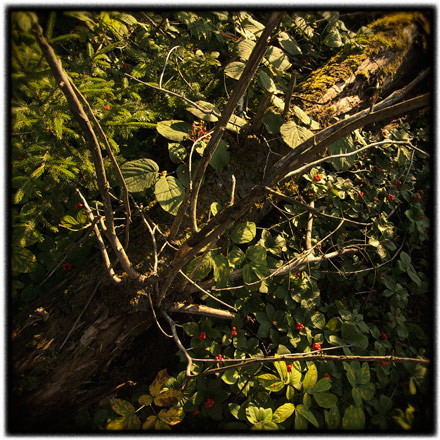ku # 531 ~ on seeing
 Thursday, August 14, 2008 at 10:24AM
Thursday, August 14, 2008 at 10:24AM 
 Fallen tree and red berries • click
Fallen tree and red berries • click
to embiggenAre you ever shocked when you realize that some of things that you do without thinking - things that are "second nature" to you - seem to be very foreign concepts to others?
Say, like ... walking, chewing gum, and breathing all at the same time. Some can do it with ease, others end up tripping all over themselves. Now maybe that's bit of an exaggeration, but you probably get the point.
In any event, I have become very aware, over the past year in particular, that a whole lot of people simply don't see in the way that I see. Some might opine that that's because I have, as a photographer, "trained my eye" to see things that others don't notice but, as I have mentioned before, that ability / condition / freak of nature / whatever you want to call it has been with me long before I ever picked up a camera. When I think about it, I am consciously aware of my propensity for intense looking as far back as early childhood. Consequently, you could say that looking and seeing are second nature to me.
And, in fact, since early childhood, I have always had a desire / need to express that looking / seeing as some form of visual "art". Throughout my youthful festering, I was repeatedly plucked from the obscurity of the lunch box rabble / blackboard jungle and presented with awards, adulation, privileges, honors, and, yes, even cold hard cash simply by doing what came easy - drawing things that I saw all around me.
Oddly enough, even though I grew up literally in the shadow of the Great Yellow Father, AKA, Kodak in Rochester NY, I never picked up a camera in earnest until I found myself living in Japan. I wanted to take pictures of the place / experience, cameras were dirt cheap and, once again, within 3 months of buying my first camera, a Petri 7s, I was plucked from obscurity and given awards, privileges, and a cushy job (as a photographer) because I was doing something that came easy - making pictures of things that I saw all around me.
Now, 41 years after that photo-awakening, I can look back upon a life in photography. It's how I made a living and how I expressed my personal looking and seeing (and continue to do both) and I have to say that the picture making always seemed easy and second nature to me.
So, it comes as a surprise to me that most others do not look and see in anything like the manner I do. It has become increasingly obvious to me that most people are almost blind to the physical world around them. They seem to look and see enough just to navigate (I mean that literally) their way around the planet but beyond that actually take notice of very little of the physical world that they inhabit.
2 cases in point -
Yesterday's picture of my picture. This framed picture, 44×30 inches, sits right inside our front door - the door that everyone uses to come and go through. One does not actually have to navigate around it when coming and going but I am at a loss to figure how anyone could not see it. So, imagine my surprise when I asked a friend of coma girl what she thought of the picture and the response was, "What picture?". I responded, "The rainbow picture." She responded, "What rainbow picture?"
It should be noted that this person had to have come and gone many times since the picture made its appearance. Apparently, it was "invisible". But even more amazing was the fact that, once we were standing in front of it, she asked, "Where was this picture taken?" I was flabbergasted - it was taken on a stretch of main highway that she must have driven by, oh, say, about a billion times in the last 19 years of her life. Once I explained where it was, she could even name the people who lived there but apparently she never "noticed" the place before. Simply amazing.
The Jersey Shore. The wife has been going to the Jersey Shore, Stone Harbor in particular, for, oh, say, 40+ years or so. It's a family affair (and it's a big family). When I first began to picture the place in earnest, 2 years ago, her response to the pictures was simply, "When I go to the Shore, that's not what I see."
Yikes.
What the hell else is there to see? Apparently, the physical world of Stone Harbor is just an incidental backdrop to family, friends, and fun. Nothing wrong or (apparently) unusual about that but I am left wondering if she would notice the physical surroundings if the family got together on the moon. Maybe. Maybe not.
It is often remarked, when someone does something remarkably stupid, "Where was he/she when they passed out the brains?" I am beginning to wonder, "Where the hell were they when they passed out the eyes?"

















